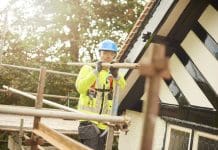Building managers should look after the hygiene of their ventilation systems in the wake of Covid-19, urges a group of industry experts
During a Building Engineering Services Association (BESA) webinar, experts warned of the importance of keeping comprehensive records and using competent companies to carry out ventilation hygiene work as buildings start to reopen.
As part of efforts to cut costs in the wake of the disruption, some businesses may look to reduce the frequency of cleaning, but this should only be done in a planned way, the association said.
Gary Nicholls, managing director of duct and legionella risk specialists Swiftclean, said the hospitality sector had been hit particularly hard, but cutting back on ventilation hygiene could increase the risk of fires being spread by poorly maintained kitchen grease extract systems.
“We need to keep grease build up below 200 microns to minimise risk,” said Nicholls.
“Owners should look at how frequently they were having systems cleaned before the lockdown and compare that with their expected turnover.”
He said it was vital that any changes were supported by accurate records to satisfy fire risk assessors and insurance companies.
Fire investigations
“In many fire investigations, there is a complete lack of adequate post-clean documentation to prove if the system had been cleaned properly,” said Nicholls.
BESA publishes the ventilation hygiene industry guide to good practice TR19 – and recently added a specification aimed specifically at kitchen extract cleaning. ‘TR19 Grease’ includes a schedule explaining the link between the frequencies of cleaning required and the average daily build-up of deposits in the extract system to help manage fire risks.
The chair of BESA’s ventilation hygiene group told the webinar that building managers should also take similar care of their supply air ventilation systems as occupancy levels start to rise again.
George Friend said there was no direct link established between the spread of the coronavirus and the cleanliness of ventilation, but that should not mean systems are not cleaned.
He said: “There have been ventilation hygiene standards in place for many years; so we are not asking people to do anything new.
“However, it is more important than ever if systems are operating on full fresh air that ductwork is properly clean.
“Building managers should also consider whether their current ventilation strategy is still fit for purpose. Many are changing layouts and having new partitions installed to maintain social distancing, which will have an impact on airflows around the occupied spaces.”
He added it was important to carry out a comprehensive survey of the ventilation system as some places, such as toilet extracts, were often overlooked.
Competence and compliance
“There is now much greater focus on the whole area of competence and compliance in light of the changes coming through the Hackitt Review,” said Duncan Sibbald, head of certification at BESA.
“Companies will have to provide proper evidence of their competence under the new regulatory regime.
“The VHE scheme was developed by the industry for the industry and allows firms to self-certify and provide reassurance to the client that their system has been cleaned to the right standard.”
Sibbald added that the scheme was recognised by the RISCAuthority, which is backed by insurance companies.
“Ventilation hygiene can often seem like an uphill battle because so many building owners just want a certificate and don’t really care about the levels of competence required, but the greater focus on building safety is changing that now,” he added.
“The levels of risk are better understood and this scheme creates a level playing field where everyone must demonstrate they are working to the same robust level of compliance.”














